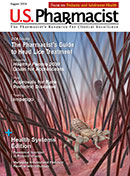Researchers recently conducted a study to estimate the point prevalence of vertigo in the U.S.
In a recent study published in JAMA Dermatology, researchers conducted a cross-sectional, population-based online survey study of more than 40,000 adults in the U.S. between December 2019 and March 2020 to obtain participant self-reported vitiligo status. A representative sample of the U.S. adult general population, aged 18 to 85 years, was recruited using a stratified, proportional sampling design from general population research panels.
Additionally, three expert dermatologists adjudicated the participants' self-reported vitiligo diagnosis. They reviewed photographs uploaded by the participants utilizing a teledermatology app designed and tested specifically for this study. The primary outcomes were the point prevalence estimates of overall vitiligo, as well as diagnosed, undiagnosed, nonsegmental, and segmental vitiligo.
The researchers found that among the 40,888 eligible adult participants, the average (SD) age was 44.9 (17.4) years, 23,170 (56.7%) were female, 30,428 (74.4%) were Caucasian, and 4,225 (10.3%) were of Hispanic, Latino, or Spanish origin. The self-reported vitiligo prevalence was 1.38% (95% CI, 1.26%-1.49%), with 0.77% (95% CI, 0.68%-0.85%) for diagnosed and 0.61% (95% CI, 0.54%-0.69%) for undiagnosed. Based on expert dermatologist review of 113 photographs of participants with self-reported vitiligo, clinician-adjudicated vitiligo prevalence (sensitivity bounds) was 0.76% (0.76%-1.11%), with 0.46% (0.46%-0.61%) for diagnosed and 0.29% (0.29%-0.50%) for undiagnosed.
Self-reported nonsegmental vitiligo prevalence was 0.77% (95% CI, 0.68%-0.85%), with 0.48% (95% CI, 0.41%-0.55%) for diagnosed and 0.29% (95% CI, 0.23%-0.34%) for undiagnosed. Clinician-adjudicated nonsegmental vitiligo prevalence (sensitivity bounds) was 0.58% (0.57%-0.84%), with 0.37% (0.37%-0.49%) for diagnosed and 0.21% (0.20%-0.36%) for undiagnosed.
Self-reported segmental vitiligo prevalence was 0.61% (95% CI, 0.53%-0.69%), with 0.28% (95% CI, 0.23%-0.33%) for diagnosed and 0.33% (95% CI, 0.27%-0.38%) for undiagnosed. Clinician-adjudicated segmental vitiligo prevalence (sensitivity bounds) was 0.18% (0.18%-0.27%), with 0.09% (0.09%-0.12%) for diagnosed and 0.08% (0.08%-0.15%) for undiagnosed.
The authors concluded that results of this survey study provide current U.S. populationÐbased prevalence estimates of overall (diagnosed and undiagnosed combined) vitiligo in adults between 0.76% (1.9 million cases in 2020) and 1.11% (2.8 million cases in 2020) and estimates that around 40% of adults with vitiligo may be undiagnosed in the U.S. They also noted that it provides prevalence estimates for segmental and nonsegmental vitiligo, and the elevated percentage of participants with undiagnosed vitiligo coupled with different rates across racial and ethnic demographic subpopulations warrants further investigation.
The content contained in this article is for informational purposes only. The content is not intended to be a substitute for professional advice. Reliance on any information provided in this article is solely at your own risk.
« Click here to return to Dermatology Update.
Published December 15, 2021





